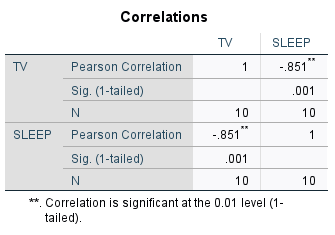1) analyze the data using pearson correlation coefficient (show the output of the analysis) 2) describe the obtained results 3) make a conclusion about whether your hypothesis was supported. hypothesis: Our hypothesis is if you watch less TV in a day, then you will sleep more hours per night.
Correlation
Correlation defines a relationship between two independent variables. It tells the degree to which variables move in relation to each other. When two sets of data are related to each other, there is a correlation between them.
Linear Correlation
A correlation is used to determine the relationships between numerical and categorical variables. In other words, it is an indicator of how things are connected to one another. The correlation analysis is the study of how variables are related.
Regression Analysis
Regression analysis is a statistical method in which it estimates the relationship between a dependent variable and one or more independent variable. In simple terms dependent variable is called as outcome variable and independent variable is called as predictors. Regression analysis is one of the methods to find the trends in data. The independent variable used in Regression analysis is named Predictor variable. It offers data of an associated dependent variable regarding a particular outcome.
1) analyze the data using pearson
2) describe the obtained results
3) make a conclusion about whether your hypothesis was supported.
hypothesis: Our hypothesis is if you watch less TV in a day, then you will sleep more hours per night.


Null hypothesis : There is no relationship between the number of hours you watch TV and number of hours you sleep.
Alternative hypothesis : There is a negative relationship between the two , that is if you watch less TV, you sleep more.
( one-tailed)
1) the Pearson correlation coefficient is computed by :
Then transfer TV and Sleep to the variable dialog box,
Tick Pearson and one-tailed then click OK.
the results obtained are attached below :


Trending now
This is a popular solution!
Step by step
Solved in 2 steps with 2 images









